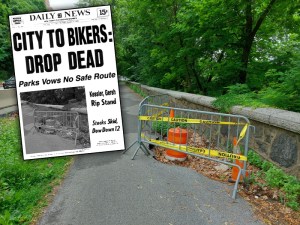UPTOWN SUNK: Parks Dept’s Poor Work on Hudson River Greenway is Already Caving In

It’s the boulevard of sunken dreams.
Parts of the Hudson River Greenway uptown are caving in just months after the Parks Department patched them up, putting cyclists and pedestrians at risk as the agency promises an investigation into faulty work on the nation’s busiest bike path.
“The patch-and-paste didn’t take,” said Danny Pearlstein, an advocate with Riders Alliance who lives in Inwood. “Especially at night, it comes upon you pretty abruptly — it can throw somebody off their bike.”
The dips developed along a 1.4-mile section of the popular path between Dyckman and W. 181st streets that Parks closed off in November to fill in previous sinkholes and reconstruct the retaining wall that holds up the greenway and the Henry Hudson Parkway.
The $1.2-million project was supposed to wrap in January, but construction is still only 10 percent done, according to the project’s tracker.
Parks closed down the greenway for just under two months during the repairs — cutting off the only safe north-south corridor for the many cyclists in upper Manhattan and the Northwest Bronx.
The agency reopened it by January, but patched spots sagged soon afterward, prompting Parks to mark the growing cavities with orange traffic cones, according to an Inwood cyclist who uses the riverside route daily.
“I don’t think it was ever done properly, so it started sinking almost immediately,” said Allegra LeGrande.

The Manhattanite worried that the repairs didn’t address underlying erosion, which could become worse when the summer rains start.
“I would guess we’re one heavy rain from whatever bit of soil is holding the patch is going to be gone,” she said. “It looks like they just laid asphalt on top and hoped for the best.”
A contractor cordoned off the sinking section on Tuesday and added extra asphalt for cyclists to bike around, according to a Parks spokesperson.
“We are currently investigating the cause of the issue,” said Izzy Verdery.
The rep added there was only “minimal” work left on the project, which will happen after the agency concludes its investigation along with the Department of Environmental Protection and the state Department of Transportation, which oversees the adjacent highway.

During the greenway’s closure last year, which was supposed to last four months but ended up being less than two months, Parks redirected cyclists on a dangerous detour through crash-prone Washington Heights streets, mostly via Broadway.
Agency officials shot down proposals by local Community Board 12 and traffic guru “Gridlock” Sam Schwartz to take one of the three adjacent highway lanes for bikes.
The Parks Department has a poor history of maintaining and repairing its bicycle facilities — which are often the only safe routes through parts of the city lacking other protected lanes.
The northern Manhattan retaining wall repairs were two months late when they started in November. The agency’s capital work has long suffered far worse delays, prompting the City Council to require Parks to figure out a plan to shave 25 percent off its project timelines by Dec. 1.
Renovations on the nearby Fort Washington Park Bridge pedestrian and bike crossing over Amtrak tracks are slated to get going later this year, a decade-and-a-half and two mayoral administrations after Parks launched the project — and a year longer than it took to build the mighty Brooklyn Bridge in the late 1800s.
The busted up Ocean Parkway malls in Brooklyn finally started getting repairs at the beginning of May, four years after the project got funding from local pols — but contractors still set up confusing signs that didn’t make it clear where cyclists should go during the renovations, telling them only to “use other side.”
